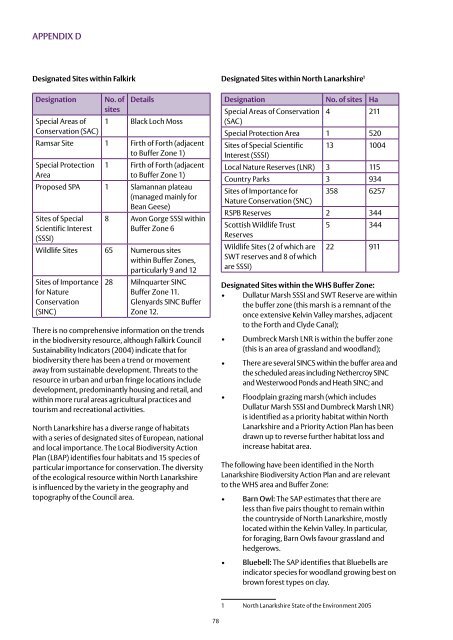The Antonine Wall Management Plan 2013-18 - Glasgow City Council
The Antonine Wall Management Plan 2013-18 - Glasgow City Council
The Antonine Wall Management Plan 2013-18 - Glasgow City Council
You also want an ePaper? Increase the reach of your titles
YUMPU automatically turns print PDFs into web optimized ePapers that Google loves.
appendix D<br />
Designated Sites within Falkirk<br />
Designation No. of Details<br />
sites<br />
Special Areas of 1 Black Loch Moss<br />
Conservation (SAC)<br />
Ramsar Site 1 Firth of Forth (adjacent<br />
to Buffer Zone 1)<br />
Special Protection<br />
Area<br />
1 Firth of Forth (adjacent<br />
to Buffer Zone 1)<br />
Proposed SPA 1 Slamannan plateau<br />
(managed mainly for<br />
Bean Geese)<br />
Sites of Special<br />
Scientific Interest<br />
(SSSI)<br />
8 Avon Gorge SSSI within<br />
Buffer Zone 6<br />
Wildlife Sites 65 Numerous sites<br />
within Buffer Zones,<br />
particularly 9 and 12<br />
Sites of Importance<br />
for Nature<br />
Conservation<br />
(SINC)<br />
28 Milnquarter SINC<br />
Buffer Zone 11.<br />
Glenyards SINC Buffer<br />
Zone 12.<br />
<strong>The</strong>re is no comprehensive information on the trends<br />
in the biodiversity resource, although Falkirk <strong>Council</strong><br />
Sustainability Indicators (2004) indicate that for<br />
biodiversity there has been a trend or movement<br />
away from sustainable development. Threats to the<br />
resource in urban and urban fringe locations include<br />
development, predominantly housing and retail, and<br />
within more rural areas agricultural practices and<br />
tourism and recreational activities.<br />
North Lanarkshire has a diverse range of habitats<br />
with a series of designated sites of European, national<br />
and local importance. <strong>The</strong> Local Biodiversity Action<br />
<strong>Plan</strong> (LBAP) identifies four habitats and 15 species of<br />
particular importance for conservation. <strong>The</strong> diversity<br />
of the ecological resource within North Lanarkshire<br />
is influenced by the variety in the geography and<br />
topography of the <strong>Council</strong> area.<br />
Designated Sites within North Lanarkshire 1<br />
Designation No. of sites Ha<br />
Special Areas of Conservation 4 211<br />
(SAC)<br />
Special Protection Area 1 520<br />
Sites of Special Scientific 13 1004<br />
Interest (SSSI)<br />
Local Nature Reserves (LNR) 3 115<br />
Country Parks 3 934<br />
Sites of Importance for 358 6257<br />
Nature Conservation (SNC)<br />
RSPB Reserves 2 344<br />
Scottish Wildlife Trust 5 344<br />
Reserves<br />
Wildlife Sites (2 of which are<br />
SWT reserves and 8 of which<br />
are SSSI)<br />
22 911<br />
Designated Sites within the WHS Buffer Zone:<br />
• Dullatur Marsh SSSI and SWT Reserve are within<br />
the buffer zone (this marsh is a remnant of the<br />
once extensive Kelvin Valley marshes, adjacent<br />
to the Forth and Clyde Canal);<br />
• Dumbreck Marsh LNR is within the buffer zone<br />
(this is an area of grassland and woodland);<br />
• <strong>The</strong>re are several SINCS within the buffer area and<br />
the scheduled areas including Nethercroy SINC<br />
and Westerwood Ponds and Heath SINC; and<br />
• Floodplain grazing marsh (which includes<br />
Dullatur Marsh SSSI and Dumbreck Marsh LNR)<br />
is identified as a priority habitat within North<br />
Lanarkshire and a Priority Action <strong>Plan</strong> has been<br />
drawn up to reverse further habitat loss and<br />
increase habitat area.<br />
<strong>The</strong> following have been identified in the North<br />
Lanarkshire Biodiversity Action <strong>Plan</strong> and are relevant<br />
to the WHS area and Buffer Zone:<br />
• Barn Owl: <strong>The</strong> SAP estimates that there are<br />
less than five pairs thought to remain within<br />
the countryside of North Lanarkshire, mostly<br />
located within the Kelvin Valley. In particular,<br />
for foraging, Barn Owls favour grassland and<br />
hedgerows.<br />
• Bluebell: <strong>The</strong> SAP identifies that Bluebells are<br />
indicator species for woodland growing best on<br />
brown forest types on clay.<br />
1 North Lanarkshire State of the Environment 2005<br />
78












![Elgin Cathedral Wedding Brochure [pdf, 544kb] - Historic Scotland](https://img.yumpu.com/22301571/1/190x151/elgin-cathedral-wedding-brochure-pdf-544kb-historic-scotland.jpg?quality=85)



